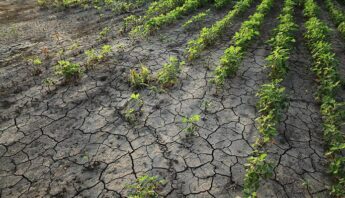For the second year in a row, farmers in Arkansas, Missouri and Tennessee are experiencing serious crop damage from exposure to the drift-prone herbicide dicamba. This is also the second growing cycle that Monsanto’s latest genetically engineered seed line — “Xtend” — has been allowed in fields. Coincidence? Not at all.
For the second year in a row, farmers in Arkansas, Missouri and Tennessee are experiencing serious crop damage from exposure to the drift-prone herbicide dicamba. This is also the second growing cycle that Monsanto’s latest genetically engineered seed line — “Xtend” — has been allowed in fields. Coincidence? Not at all.
Xtend soy and cotton are designed to withstand repeated, heavy applications of both glyphosate (the primary ingredient in Monsanto’s RoundUp) and dicamba. With more planting of Xtend seeds comes increased use of dicamba — which is toxic to broadleaf plants, including fruits, nuts, vegetables and non-GE soybeans. And dicamba tends to drift from where it’s applied to neighboring fields, causing serious problems for farmers growing anything except Xtend crops.
Monsanto attempted to address the drift issue with a new formulation of dicamba, which was approved for use last year (one year after Xtend seeds were put on the market). In November 2016, EPA granted conditional registration for this newer iteration of dicamba, in time for use on this year’s crops.
But not everyone is using this new, more expensive formulation in the field. And being “less drift-prone” than the original formulation still doesn’t render it harmless to non-target crops.
Drastic measures call for decisive action
With an earlier growing season than several neighboring states, Arkansas farmers have already been hit hard by dicamba drift damage. As of June 28, the state agricultural department had received over 420 dicamba misuse complaints spread across 20 counties. So the state is taking action to ban dicamba use, period.
Growers in Missouri and Tennessee are also starting to see serious damage, with more expected as their growing seasons heat up.
Upsetting, but not surprising
Before Monsanto’s new GE seeds were approved for use over two years ago, scientists warned that planting Xtend crops would lead to increased applications of dicamba and the development of dicamba-resistant superweeds — just as we saw with RoundUp Ready crops and glyphosate.
The drift damage predictions are clearly being borne out. And before Monsanto can claim that the problem lies with farmers spraying the old dicamba formulation (even though they were warned against it), University of Missouri professor Kevin Bradley explains:
All the calls I’ve had this year, these are people that are spraying the newly approved products. They’re doing the best they can do.”
Tom Burnham, an Arkansas grower who estimates that all of his 7,500 acres of soybeans have symptoms of dicamba damage concurs:
These weren’t what I call cowboys using the old versions of dicamba. These were people using the right stuff the right way.”
The solution is in the seed
Burnham estimates that half of the region’s acreage planted in dicamba-resistant crops this year was done by farmers solely aiming to protect themselves from drift damage. In the face of a loss of his entire soybean crop, he argues that rampant drift unfairly influences the choices of non-GMO farmers, stating,
I feel that the need to plant a technology to protect your crop from off-target movement is tantamount to extortion.”
That may indeed align with Monsanto’s plan.
Join PAN in telling Secretary of Agriculture Sonny Perdue to support farmers and pull Xtend crops off the market.
The model of engineering seeds to withstand repeated applications of herbicides is short-sighted and deeply flawed. It’s time for USDA to get behind solutions that support farmers in the long run.







